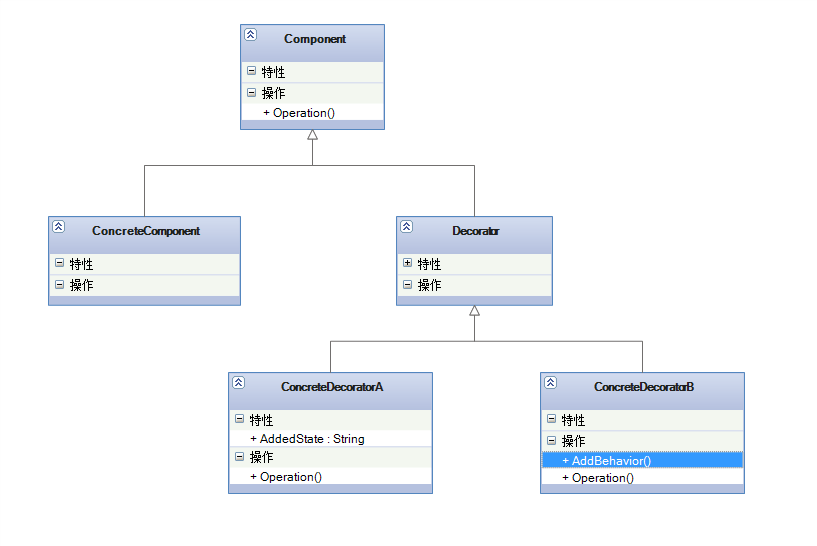设计模式之六(装饰模式)
前言
装饰模式:动态の给一个对象添加有些额外的职责,就增加功能来说,装饰模式比生成子类更为灵活。
装饰模式结构图

Component是定义一个对象接口,可以给这些对象动态添加职责
ConcreteComponent是定义了一个具体的对象,也可以给这个对象添加一些职责
Decorator装饰抽象类,继承了Component,从外类来扩展Componnt类的功能,但对于Component来说,是无需知道Decorator的存在的
代码实现
Component类
public abstract class Component { public abstract void Operation(); }
ConcreteComponnet类
public class ConcreteComponent : Component { public override void Operation() { Console.WriteLine("具体对象的操作"); } }
Decorator类
public abstract class Decorator : Component { protected Component component; /// <summary> /// 设置Component /// </summary> /// <param name="component"></param> public void SetComponent(Component component) { this.component = component; } /// <summary> /// 重写Operation,实际执行的是Component的Operation /// </summary> public override void Operation() { if (component != null) { component.Operation(); } } }
ConcreteDecoratorA
public class ConcreteDecoratorA : Decorator { /// <summary> /// 本类独有功能,以区别于ConcreteDecoratorB /// </summary> private string AddedState; public override void Operation() { base.Operation(); AddedState = "NewState"; Console.WriteLine("具体装饰对象A的操作"); } }
ConcreteDecoratprB
public class ConcreteDecoratorB : Decorator { public override void Operation() { base.Operation(); } /// <summary> /// 本类独有的方法,以区别于ConcreteDecoratorA /// </summary> private void AddedBehavior() { /// } }
客户端调用实例
public class Program { static void Main(string[] args) { ConcreteComponent cc = new ConcreteComponent(); ConcreteDecoratorA ca = new ConcreteDecoratorA(); ConcreteDecoratorB cb = new ConcreteDecoratorB(); ca.SetComponent(cc); cb.SetComponent(ca); cb.Operation(); Console.ReadLine(); } }
装饰的方式是:首先用ConcreteComponent实例化cc,然后用ConcreteComponentA的实例化对象ca来包装cc,再用ConcreteComponetB的对象cb包装ca,最终执行cb的Operation()
其实就是利用Setcomponent来对对象进行包装的。这样每个装饰对象的实现就和如何使用这个对象分离开了,每个装饰对象只关心自己的功能,不需要关心如何被添加到对象链当中。
不过也有特殊情况:如果只有一个ConcreteComponent类而没有抽象的Component类,那么Decorator类可以是ConcreteComponent的一个子类。同样道理,如果只有一个ConcreteDecorator类,那么就没必要建立单独的Decorator类,而可以把Decorator和ConcreteDecorator的责任合并成一个类。
总结
装饰模式就是为已有功能动态添加更多功能的一种方式。
优点可以这样说:把类中的装饰功能从类中搬移去除,这样可以简化原有的类。有效的把类的核心职责和装饰功能区分开了。






【推荐】国内首个AI IDE,深度理解中文开发场景,立即下载体验Trae
【推荐】编程新体验,更懂你的AI,立即体验豆包MarsCode编程助手
【推荐】抖音旗下AI助手豆包,你的智能百科全书,全免费不限次数
【推荐】轻量又高性能的 SSH 工具 IShell:AI 加持,快人一步
· 10年+ .NET Coder 心语,封装的思维:从隐藏、稳定开始理解其本质意义
· .NET Core 中如何实现缓存的预热?
· 从 HTTP 原因短语缺失研究 HTTP/2 和 HTTP/3 的设计差异
· AI与.NET技术实操系列:向量存储与相似性搜索在 .NET 中的实现
· 基于Microsoft.Extensions.AI核心库实现RAG应用
· TypeScript + Deepseek 打造卜卦网站:技术与玄学的结合
· 阿里巴巴 QwQ-32B真的超越了 DeepSeek R-1吗?
· 【译】Visual Studio 中新的强大生产力特性
· 10年+ .NET Coder 心语 ── 封装的思维:从隐藏、稳定开始理解其本质意义
· 【设计模式】告别冗长if-else语句:使用策略模式优化代码结构